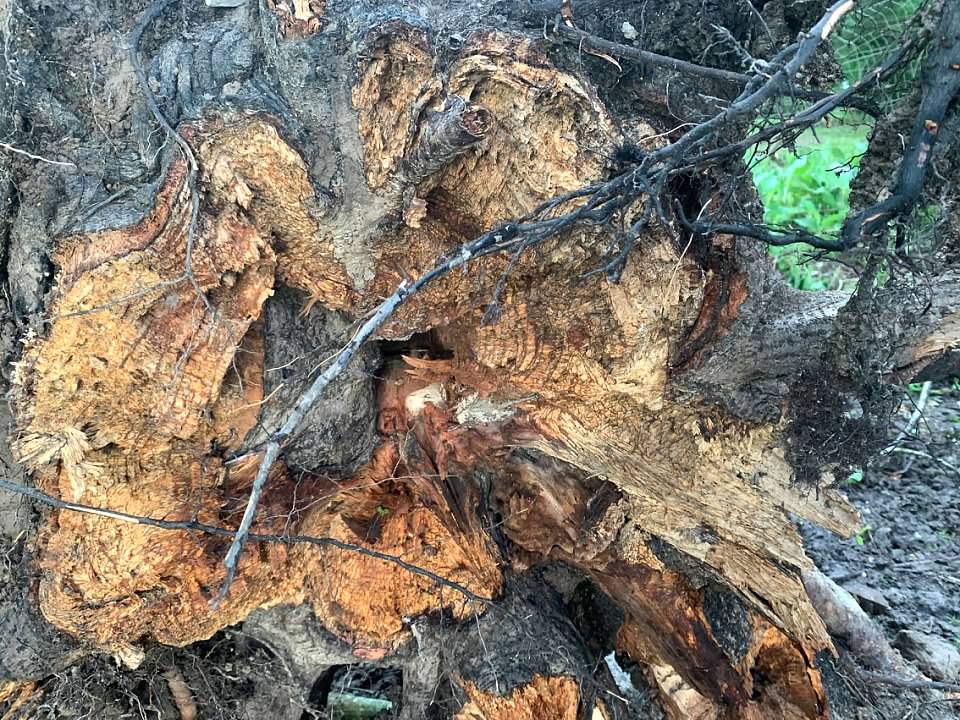Therefore, as a tongue of fire consumes stubble And dry grass collapses into the flame, So their root will become like rot and their blossom blow away as dust; For they have rejected the law of the Lord of hosts And despised the word of the Holy One of Israel. Isaiah 5:24
A little over a week ago, we had strong a strong storm that blew through from the west, bringing with it 80 mph straight-line winds that caused lots of damage and blew down a pretty decent sized pecan tree in our pasture next to the barn that provided nice shade in the sweltering heat of the summer. The animals would sit under its shade in the heat of the day, chewing their cud. Those days are gone. The cows and goats are going to miss that tree. We will miss that tree.
The funny thing is, the pecan tree, being the last tree to bud out in the spring, didn't have many leaves yet. There wasn't a lot of resistance to cause it to topple over. It seems like the wind would blow right past it with no leaves to buffet against. It was a mystery to me how it could have fallen.
And then I took a closer look. Although the outside of the tree looked fine, the inside of the tree was rotten. It was dying from the inside out. Just by looking at the exterior of the tree, you would have never known that it had a terminal illness. Probably an arborist could have identified symptoms, but to anyone else, the rottenness inside was hidden from sight. But it was only a matter of time. The clock was ticking. On April 10th, as strong winds blew, the pecan tree's last grain of sand dropped through the hour glass. Crash!

Overly dramatic, I know, but this malady isn't only restricted to trees, it is present and prevalent in nations and in people. Our country, that once stood strong, is rotting from within. We can stick our heads in the sand or we can face it. Our Judeo-Christian heritage and values that once set us apart and put our feet on a strong foundation, has been under attack. The family structure is falling. Church attendance dropping precipitously. We're deconstructing every norm, questioning every standard of truth, incentivizing all that's immoral and punishing all that's good, and right, and pure. We've left God behind and if Jesus is mentioned, it is in a swear word. Meanwhile, we're steadily rotting from within.
As people, we may look good from the outside. We can put up a nice façade and put a new coat of paint on our barn that makes bystanders think all is well, but within, things aren't what they seem. It's sinister and nefarious. We can hide it for a little bit, whistling past the graveyard, but there are storm clouds brewing. When the metaphorical strong winds begin to blow, the rot hidden inside our nation and inside the heart of man will have weakened us so that we cannot stand. Try as we might with all our strength, we will not be able to withstand by human force or will. We will topple and oh, what great destruction will occur.
The rotten pecan tree fell on another tree seen in the photo below, snapping it in half. See, that's the thing. There will be people who are faithful and virtuous, but they'll be caught in the wind, too, and won't be immune to the cataclysmic fall when the rottenness around them negatively affects them too, snapping them in half. The Bible tells us that the rain falls on the just and the unjust alike.
As I was looking at the rotten tree, something caught my eye that was imbedded in the dirt in the very center of the tree. In the place that it was, it had to have been there for, I'm guessing 50 years or more. It was a stick of welder's chalk, still pointed!
Welder's chalk is made of soapstone and welders use it to mark steel plate that they've measured for cutting. We live at the border of what used to be a rice field, and I assume that half a century ago, a farmer's implement broke down. He pulled his implement to the edge of the field, got some metal plate perhaps to weld reinforcement on the tongue of a plow. He measured and marked it for cutting with his welder's chalk and, when the repairs were done, threw the chalk next to a little pecan tree sapling that was growing on the fence line.
Fifty years later, here we are. Oh, that we as a nation might repent and turn to Jesus. Oh that we'd get some welder's chalk and mark the reinforcement of God's Word to apply to our weakened core and fix what's broken. I used that half a century old chalk to commemorate the strong winds that knocked down the pecan tree on the wall of our hen house.
There's more strong winds coming. Will we be able to stand?
Therefore, my beloved brethren, be ye stedfast, unmoveable, always abounding in the work of the Lord, forasmuch as ye know that your labour is not in vain in the Lord. 1 Corinthians 15:58